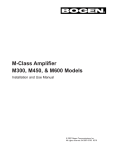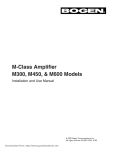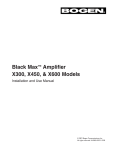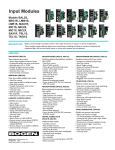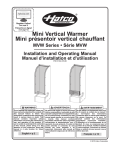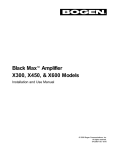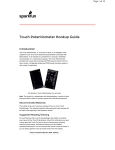Download Bogen M450 Specifications
Transcript
M-Class Amplifier M300, M450, & M600 Models Installation and Use Manual © 2001 Bogen Communications, Inc. All rights reserved. 54-2037-01D 1205 Notice IMPORTANT Every effort was made to ensure that the information in this guide was complete and accurate at the time of printing. However, information is subject to change. Important Safety Information WARNING: To Reduce The Risk of Fire Or Electric Shock, Do Not Expose This Apparatus To Rain Or Moisture. Always follow these basic safety precautions when installing and using the unit: 1. 2. 3. 4. 5. 6. 7. 8. 9. 10. 11. 12. 13. Read these instructions. Keep these instructions. Heed all warnings. Follow all instructions. Do not use this apparatus near water. Clean only with dry cloth. DO NOT block any ventilation openings. Install in accordance with the manufacturer’s instructions. Do not install near any heat sources such as radiators, heat registers, stoves, or other apparatus (including amplifiers) that produce heat. Do not defeat the safety purpose of the polarized or grounding-type plug. A polarized plug has two blades with one wider than the other. A grounding-type plug has two blades and a third grounding prong. The wide blade, or the third prong, are provided for your safety. If the provided plug does not fit into your outlet, consult an electrician for replacement of the obsolete outlet. Protect the power cord from being walked on or pinched, particularly at plugs, convenience receptacles, and the point where they exit from the apparatus. Only use attachments/accessories specified by the manufacturer. Unplug this apparatus during lightning storms or when unused for long periods of time. Refer all servicing to qualified service personnel. Servicing is required when the apparatus has been damaged in any way, such as power-supply cord or plug is damaged, liquid has been spilled or objects have fallen into the apparatus, the apparatus has been exposed to rain or moisture, does not operate normally, or has been dropped. CAUTION: TO PREVENT THE RISK OF ELECTRIC SHOCK, DO NOT REMOVE COVER (OR BACK). NO USER-SERVICEABLE PARTS INSIDE. REFER SERVICING TO QUALIFIED PERSONNEL. The lightning flash with arrowhead symbol, within an equilateral triangle, is intended to alert the user to the presence of uninsulated “dangerous voltage” within the product’s enclosure that may be of sufficient magnitude to constitute a risk of electric shock to persons. The exclamation point within an equilateral triangle is intended to alert the user to the presence of important operating and maintenance (servicing) instructions in the literature accompanying the appliance. Contents Page INTRODUCTION ..................................................................................................1 Package Contents................................................................................................................1 PANEL DESCRIPTIONS ....................................................................................2-3 M-Class Front Panel............................................................................................................2 M-Class Rear Panel ............................................................................................................3 INSTALLATION ..................................................................................................4-6 Installation Components....................................................................................................4 Ventilation ............................................................................................................................5 Rack Mounting ....................................................................................................................5 Rear Rack Mounting ..........................................................................................................5 Table Mounting ....................................................................................................................5 Module Installation..............................................................................................................6 CONNECTIONS ....................................................................................................7 Speakers ................................................................................................................................7 Low-Impedance Speaker Connections ................................................................7 Earth Ground Terminal..........................................................................................7 70V “Transformer-Coupled” Speakers ................................................................7 Standard Input Module ......................................................................................................7 Balanced Input Connections ................................................................................7 Unbalanced Input Connections ............................................................................7 OPERATION ......................................................................................................8-11 Controls & Connectors ................................................................................................8-9 Level Controls ........................................................................................................8 Sleep Mode Defeat ..............................................................................................8 Channel Balance....................................................................................................8 Lo-Cut Switch ........................................................................................................8 Effects Loop............................................................................................................9 Output Feeds..........................................................................................................9 Modes of Operation ....................................................................................................9-10 Stereo Mode ..........................................................................................................9 70V Mono Mode ................................................................................................10 Dual Mono Mode ..............................................................................................10 Audio Buses ........................................................................................................10 Modules ..............................................................................................................................11 Standard Input Module ......................................................................................11 Standard Input Module Priority Jumper..................................................................11 Standard Input Module Gain Switches ..................................................................11 Other Input Modules ..........................................................................................11 Module Priority ....................................................................................................11 Module Controls ..................................................................................................11 APPLICATIONS ..............................................................................................12-13 TROUBLESHOOTING ........................................................................................14 SPECIFICATIONS ................................................................................................15 Introduction Bogen's M-Class amplifiers deliver on what professional sound installers need most: Flexibility, Power, and Reliability. Flexibility The M-Class allows for the installation of up to 2 input modules, accepting inputs from microphones, telephone systems, stereo sources, mono sources, or daisy-chaining of amplifiers. Each M-Class model comes standard with a single, professional-quality, stereo, high-impedance balanced input module. The M-Class has three operating modes to meet different installation needs - Stereo, Dual Mono, or 70V Mono. Front panel controls allow independent operation of each power amplifier channel in stereo mode. In either 70V Mono or Dual Mono modes, the inputs form a 2:1 mixer with the front panel controls setting the signal levels from each input. Prioritized input modules and 2:1 mixer operation allow the M-Class to supply the frontend signal processing required in paging systems and the power to cover any size installation. Power With three different models (M600, M450, and M300), the M-Class provides 2-channel operation at 600W, 450W, and 300W per channel into 4-ohm loads. Single channel, 70V Mono operation capacities are 1200W, 900W, and 600W. Along with being powerful, these amplifiers are also compact - using up only 2 rack spaces (3-1/2") in a standard 19" rack. Reliability Driven by a conservatively-rated toroidal power transformer, these amplifiers are built for solid performance with low distortion and a high slew rate. Output module circuitry is located away from input module circuitry, minimizing noise and ground loops. The amplifiers require little maintenance and cleaning as internal electronic components are located outside of the forced air-stream flow. Front-mounted fan filters provide easy removal and cleaning. M-Class amplifers have a variety of electronic protection circuits including overcurrent, DC voltage, and thermal circuits. A special Clip/Limiting circuit continuously monitors the amount of distortion in the output signal and reduces input levels as the amplifier approaches clipping. Back-Slope™, Bogen’s unique voltage stabilization circuitry, regulates the AC energy supplied from the power toroid. This improves both system performance and reliability despite varying AC supply conditions. An energy-conserving sleep mode (defeatable) with instant-on return signal operation reduces wasted heat production in paging systems with intermittent use. In addition, large output heatsinks and dual independentlycontrolled, high-output, variable speed fans provide superior cooling and quiet operation while reducing dust accumulation. Bogen's M-Class amplifiers are enclosed in a heavy-gauge steel chassis, which prevents mechanical damage to the unit's internal components even if the unit is subjected to rough handling and excessive portable installations. The control knobs are located in a recessed section of the cast aluminum front panel to reduce the likelihood of mishandling and damage. The angled design of the amplifier's front panel allows easy finger access to the front knob cover when the amplifiers are stacked tightly in a rack. Package Contents * M-Class Amplifier * 2 Rack Ears * 2 Filters and Grilles * Instruction Manual * Control Knob Cover * Balanced Input Module (pre-installed) * 4 Rubber Feet & Screws 1 Panel Descriptions M-Class Front Panel 1. Status Indicators The Status LED is a multi-purpose indicator that lights in three colors to show status. One for each channel. • • • Green - Amplifier is on and operating normally. Amber - Amplifier is in low-power consumption Sleep Mode. Red - Amplifier has protected itself due to a fault condition. 2. Signal Indicators Illuminates green when signal is present at the input. One for each channel. 3. Clip/Limit Indicators This indicator illuminates amber when there are excessive signal levels or very low impedance output loads. A built-in Clip/Limiting circuit activates and reduces input signal levels when output distortion exceeds a few percent or when the output load draws too much current. One for each channel. 4. Power Switch/Circuit Breaker Controls AC power to the amplifier and also works as a circuit breaker. If the circuit breaker trips, push it to the OFF position (O) and then to the ON position ( l ). 5. Fan Grilles Removable fan grilles are provided to allow access to the dust filters for cleaning. 6. Volume Controls Detented (40 position) knobs are recessed for protection from mechanical damage. One for each channel. Knob Cover (not shown - see #4 on page 4) Removable cover protects both volume controls from casual tampering or brushing. 2 Panel Descriptions M-Class Rear Panel 1. Low-Impedance Outputs Accepts up to #10 spade lugs for low-impedance speaker connections. 2. Channel Balance Only active in Dual Mono mode. Allows one channel’s volume to be adjusted relative to the other channel. 3/4. Effects Loop In/Out The effects loop connectors provide an insertion point for outboard signal processing equipment when the M-Class is operating in either 70V Mono or Dual Mono mode, where inputs provide a 2:1 mixer function. 5/6. Output Feeds (Pre/Post-EQ) Two different output feeds are provided that can supply signal to other audio equipment. Both outputs are designed to feed high-impedance, unbalanced inputs of external equipment. The Pre-EQ Output Feed provides a signal before any external signal processing. The Post-EQ Output Feed provides a signal that has been affected by the external signal processing equipment and the lo-cut filter. 7. Operational Mode Selector The M-Class amplifier has 3 distinct modes of operation (Stereo; 70V Mono; Dual Mono) that are designed to provide a wide range of application coverage. For a description of the different modes, see the Operation section of this manual. 8. Fan Exhausts Two independent, variable speed cooling fans respond as needed to keep the amplifier cool and reduce dust build-up. 9. 70V Mono Speaker Output For 70V constant voltage speaker systems. Provides a single channel of amplification. 10. Chassis Ground Provides convenient access to earth ground. 11. Lo-Cut Switch Select a low-frequency roll-off of 65 Hz or 125 Hz for transformer-coupled and horn speakers. Flat position allows full low-frequency performance. 12. Module Bay Accepts one or two Bogen input modules (one module included with amplifier). 3 Installation Installation Components 1. Rack Ears Prior to installing the amplifier, you will need to attach the installation rack ears if you intend to install the amplifier in a rack and complete the setup process. Remove the 6 front most cover screws on each side panel of the amplifier and attach rack ears as shown. 2. Dust Filter Insert the dust filter into the fan grille before attaching the fan grille to the amplifier. Filter Maintenance Dust filters are provided with the M-Class amplifier to reduce the build up of dust on the heat sinks. Periodic cleaning should be done when there is a noticeable build up of dust on the filters. To clean the filters, remove them from the grilles and wash, vacuum, or tap them out. Promptly replace them. Caution: The fan blades are accessible when the grille cover and filter are removed. Be careful not to place your finger or other objects into the fan. 3. Fan Grille To insert or replace the grilles, first insert the tabs on the wider end of the grille in to the notches in the front, center casting. Snap the other end of the grille in to the snap slots. Check that the grille is securely in place. To remove, pry the end of the cover closest to the rack ears up until the snap tabs disengage. 4. Knob Cover To protect the amplifier controls from casual tampering, the volume level controls are concealed behind a removable cover. The cover snaps into place with tabs at the top and bottom. To remove the cover, squeeze both ends of the cover, then gently dislodge the top and then the bottom. Be careful not to tip the top of the cover too far forward while removing or the snap-in tabs could be damaged. To replace, simply snap it back into place. 4 Installation Ventilation The M-Class was designed to be placed on a table or rack-mounted. When rack mounted, the amplifiers can be stacked one on top of the other for maximum use of the rack. An open air space of at least 4" must be provided at the front air intakes of the amplifier, and the rear exhaust must have at least a 4" gap from any obstructions to ensure adequate cooling. This applies to both rackand table-mounted amplifiers. Care should also be taken to ensure that the front intake air is not considerably warmer than the ambient air temperature. Mount the amplifiers low in the rack so that heat dissipation from other equipment does not warm the amplifier's intake air. Rack Mounting Rack ears are included with the amplifier to allow mounting in 19" racks. Attach the rack ears as shown in the Installation Components section. If any feet have been attached to the bottom of the amplifier, remove them. Load the amplifier into the rack and secure it to the rack with appropriate hardware (not included). Rear Rack Mounting For greater rear support when rack mounting an M-Class amplifier, the RPK86 Rack Mounting Kit (not included) can be attached to the rear of the amplifier by following the steps below. 1. Remove and save the three cover screws from the chassis of the amplifier. 2. Position the rack attachment as shown. 3. Replace and tighten the three cover screws to secure the rack attachments. Table Mounting Feet are provided with the amplifier to allow it to be placed on a tabletop. Attach the included feet to the bottom of the amplifier as shown. Attachment of the rack ears to the unit is optional and purely aesthetic for table mounting. 5 Rear of Amplifier Installation Module Installation Installation Two input module bays are available to accept various Bogen input modules thereby allowing users to customize the amplifier to suit the needs of the installation. Read the instructions included with the module and make the desired jumper setting changes before installing the module. The sleep switch should be set to the desired position prior to installation of the right module since it will be covered by the module (see Operation, Sleep Mode Defeat). The input modules are installed by simply sliding them along the card guides inside the module bays until the faceplate firmly sits against the M-Class chassis, then use the two screws supplied with the module to secure it to the chassis. Note: The input module included with the amplifier is pre-installed and factory set for 0 dB gain (can also be changed to 18 dB boost) and to be muted by any other module (can also be set to “no mute”). To change those settings, refer to the manual included with the module. 6 Connections Speakers Low-Impedance Speaker Connections When the amplifier is set to either the stereo mode or the Dual Mono mode (see Operation section), low-impedance speakers can be connected to either the "A" or "B" speaker output terminals. The amplifier is designed to work into speaker load impedances as low as 3.2 ohms. The speaker terminals can accept up to a #10 spade lug and have integral clamping plates which make wiring easier. The polarity of each set of speaker outputs (A & B) is indicated with a "+" and "-" sign. Use these indicators to ensure that the phasing of the speakers are correct. Do not ground the "+" output of either set of outputs. Doing so will cause the amplifier to go into protect mode, shutting down operation of the affected channel. Note: The "+" and "-" indicators are mirrored on "A" and "B" outputs. Be sure to make the correct connections. Earth Ground Terminal The earth ground terminal is provided as a convenient means to connect to the amplifier’s chassis/AC ground, if necessary. DO NOT connect the earth ground terminal to the "+" terminals of either output. No damage will occur if this is done, but the amplifier will go into protect mode and shut down the effected channel. 70V "Transformer-Coupled" Speakers The 70V speaker output terminals are only usable when the amplifier is in the 70V Mono mode (see the Operation section). In this mode, both channels are bridged into a single mono channel. Use only speakers that are designed to work with 70V audio systems when connecting to these terminals. The speaker terminals can accept up to a #10 ring lug and have integral clamping plates which make wiring easier. The 70V output terminals are indicated by a yellow field above them. The polarity of the output terminals is indicated for speaker phasing purposes. These output terminals must float and cannot be referenced to earth ground, so if they become grounded, the amplifier will go into protect mode, shutting down operation of the amplifier even though no damage to the amplifier will occur. Standard Input Module (included) Balanced Input Connections Balanced input connections are used when the source device provides a balanced output (signal "+", signal "-", and ground "G"). This type of connection is desirable when operating in electrically noisy environments, where long input cable runs are needed, or to ensure the lowest noise operation. If compatible with the source device, this type of connection is recommended. Unbalanced Input Connections When the source device provides only an unbalanced output (signal and ground), the input module should be wired with the "-" input shorted to ground (G). The unbalanced signal's shield wire is connected to the input module’s ground and the signal hot wire is connected to the "+" terminal. Since unbalanced connections do not provide the same amount of noise immunity that a balanced connection does, the connection distances should be made as short as possible. 7 Operation Controls & Connectors Level Controls The front-mounted level controls act differently depending on the mode of operation. In the stereo mode, each level control determines the volume of the corresponding amplifier channel as in a typical amplifier. In the 70V Mono and Dual Mono modes, the controls have a different function and determine the mix of the signal levels from the different input modules (input modules can be assigned to either the "A" or "B" channel by the jumpers on the module). The front level controls determine the mix of the two input module signals. They do not control the volume level of each amplifier in these modes. Essentially, the volume level of both amp channels is fixed at maximum and the overall level of the mixed input module signals determine the output volume level. To increase the overall volume of the amplifier output, turn up both front panel controls by the same amount. This increases the signal level of each module's input into the amplifier while keeping the mix the same. Similarly, turn down both controls to the same knob position to reduce the overall output volume from the amplifier. Sleep Mode Defeat The M-Class amplifier includes a sleep mode feature that greatly reduces the power consumption of the amplifier after it has been idle for more than 3 minutes. Any audio activity present at the input will wake the amplifier up instantaneously so that there is no loss of audio. A sleep mode switch located in the upper right hand corner of the module bay can be set to activate or deactivate this feature using a thin, flat-bladed screwdriver. (If a module is inserted in the right bay, turn off the power and remove the module before proceeding.) If the sleep feature is desired, make sure the switch is in the down position. If the sleep feature is not desired, make sure the switch is in the up position. Channel Balance Channel Balance only works in the Dual Mono mode of operation. In Dual Mono mode, both amplifier channels get the same audio program at the same level. To provide some direct control over the amplifier volume levels, a Channel Balance control is provided. This control allows the adjustment of one amplifier channel output volume over the other. To reduce the volume level of channel "B" while leaving the volume of channel "A" unchanged, the Channel Balance control is rotated counterclockwise. The diminishing arrow with the "B" next to it indicates that rotating the control in that direction diminishes the "B" channel volume. Likewise for reducing channel "A" volume. Putting the control at the center of rotation allows equal, and maximum, volume from both channels. Lo-Cut Switch The M-Class amplifier is a direct-coupled amplifier, which means that there are no output transformers used to deliver the 70V audio to the speakers. Because of this, the M-Class amplifier has a Flat frequency response below 20 Hz. This extended low frequency operation can be troublesome for some transformer-coupled speakers typically used in 70V audio systems. The relatively inexpensive transformers used in these speakers cannot handle frequencies much below 60 Hz. When frequencies lower than this are applied to these speaker's transformers, they can saturate causing distortion and high instantaneous power consumption. The Lo-Cut filter allows a low frequency roll-off to be introduced into the output signal preventing the speakers from receiving too much low frequency content. The 65 Hz position should be used for all transformer coupled cone type speakers. The higher frequency roll-off of 125 Hz provides an extra level of safety for horn speakers. Some horn speakers can be adversely affected by frequencies below 120 Hz since they are designed to reproduce higher frequency signals. 8 Operation Effects Loop The effects loop connectors act as an insertion point for outboard signal processing equipment when the M-Class is operating in either the 70V Mono or Dual Mono modes. In these modes, the inputs and front panel controls form a 2:1 mixer. Connect the Effects Loop Out to the input of the external signal processing equipment. Connect the Effects Loop In to the output of the external signal processing equipment. Inserting an RCA jack into the Effects Loop In connector will automatically disconnect the input module signals from the power amp stage so it can be routed through the external equipment. Removing the jack from the Effects Loop In connector will reestablish the direct connection of the input modules to the power amp stage. The Effects Loop signals are quasi-balanced, which means that they are intended for use with unbalanced equipment but will improve the noise immunity. However, it is still a good practice to keep these connections as short as possible. Output Feeds Two different output feeds are provided that can supply signal to other amplifiers and audio equipment. Both outputs are designed to feed high-impedance, unbalanced inputs of external equipment. The outputs are also quasi-balanced for better noise immunity, but connection lengths for these outputs should still be kept as short as possible. The Pre-EQ Output Feed provides the signal before any external signal processing affects it. The Post-EQ Output Feed provides a signal that has been affected by the external signal processing equipment and lo-cut filter. Depending on the application, it may be more desirable to use the externally-processed signal rather than the raw version of the signal. Modes of Operation Stereo Mode Placing the 3-position switch to its left most position puts the amplifier in the stereo mode of operation. The amplifier supplies two independent channels of low-impedance amplification in this mode (see Stereo Mode Block Diagram). These channels can be used to supply left and right audio for stereo installations of 2 separate zones of amplification with different audio programs. When using the supplied input module in this mode, the input applied to the "A" input will be controlled by the "A" level control and the output will be available on the "A" channel speaker terminals. Likewise for the "B" channel. When using other modules, there are jumper settings that allow those modules to apply signal to the "A" or "B" channels, or both. See the application examples for more information on how to use the two audio buses. Stereo Mode Block Diagram 9 Operation 70V Mono Mode Placing the 3-position switch to its right most position puts the amplifier in the 70V Mono mode of operation. The amplifier supplies a single channel of amplification in this mode (see 70V Mono Mode Block Diagram). This mode also mixes the signals from each input module into a mono program. Input signals of modules that are assigned to the "A" bus are controlled by the "A" level control on the front of the unit and likewise for modules whose outputs are assigned to the "B" bus. By assigning each module to a different bus, a 2:1 mixer is formed with the front-mounted level controls adjusting the mix. Additionally, one module can be set to mute the other when it is active, thereby providing an effective paging system (see the section on Module Priority). It is important in this mode to set the assignment jumpers on the two input modules so that their outputs are on different audio buses (see the section on Audio Buses). Speakers must be correct for 70V operation. (See section on 70V “Transformer-Coupled” Speakers). 70V Mono Mode Block Diagram Dual Mono Mode Block Diagram Dual Mono Mode Placing the 3-position switch to its center position puts the amplifier in the Dual Mono mode of operation. This mode is similar to the 70V Mono mode except that the amplifier supplies two channels of low-impedance amplification in this mode (see Dual Mono Mode Block Diagram). This mode still mixes the input signal from the different modules but a Channel Balance control is provided to adjust the output levels of one channel against the other (see the section on Channel Balance). It is important in this mode to set the assignment jumpers on the two input modules so that their outputs are on different audio buses (see the section on Audio Buses). Speakers must be low-impedance type, not 70V type. Audio Buses The M-Class amplifier contains two separate audio buses. The "A" bus level is adjusted by the "A" level control on the front of the unit and the "B" bus is adjusted by the "B" Level control. Most Bogen modules provide a means to assign their output to either or both of the audio buses. The instructions that accompany the modules will describe the jumper settings for these assignments. When using the M-Class amplifier in either the 70V Mono or Dual Mono modes, the module signals will be mixed. For maximum control when mixing signals, it is important that each of the two input modules be set so that the outputs feed different audio buses. Otherwise, proper mixing of the signals will be difficult. Check that each module is set to a different audio bus before installing it. 10 Operation Modules Standard Input Module The M-Class is shipped with one input module pre-installed. The module provides 2 high-impedance, balanced, lownoise inputs, but can be replaced by other modules if desired. The input’s connectors, labeled A & B, correspond to the similarly marked rear speaker connections and front panel controls. The module’s inputs are permanently assigned to their respectively-labeled audio buses. Standard Input Module Priority Jumper The input module that comes standard (and pre-installed) with the M-Class differs in priority capability from other Bogen input modules. The module has a priority jumper that can set it to be muted by any other modules installed or to never mute. Since it is incapable of muting other modules, it is always the lowest priority module. When signaled to mute by another module, it will reduce the level of both channel’s input signals by the amount set by the ducking control (DUCK). When the mute is released, the module will fade the input signal levels back to the previous level. When set to No Mute, it does not respond to muting from other modules and is, therefore, always available for use in mixing applications. The module is factory set to be muted by any other module. The module will have to be removed to change this setting. Standard Input Module Gain Switches A separate gain switch for each input channel is included in the module that comes pre-installed with the amplifier. The module is factory set for 0 dB gain. Set each switch for the channel’s desired gain, either 0 dB (X1) or 18 dB (X8). Other Input Modules Various input modules can be installed in the M-Class amplifier. Refer to the instructions that come with each module for specific connection and setup information. The module jumpers must be set prior to installing the module. Module Priority Bogen input modules allow for up to 4 levels of priority. Each module (except the included input module, which comes standard with the amplifier) can both be muted by higher priority modules and mute lower priority modules. The priority level of the module is set by the position of 2 jumpers on each module. Note: Even though 4 priority levels are available on the Bogen input modules, only two levels can be used with the M-Class since it only accepts 2 modules. It does not matter which priority level is set on the module, only that the intended higher priority module be set to some priority level that is higher than the intended lower priority module. However, Bogen recommends using Priority Level 1 (the highest available) for the higher priority module and Priority Level 2 for the lower priority module. Module Controls Each input module type has a number of controls such as Gain, Bass, and Treble. These controls affect the operation of the amplifier as much as the ones mounted on the amp. Be sure to read the instructions with each module and be aware of its control setting when adjusting the overall operation of the amplifier. 11 Applications Application Examples Application 1: Simple 1-Zone, 70V Mono telephone paging system with background music Background music plays through the system when no page is being made. During a telephone page, the background music mutes to a predetermined level and the telephone page is heard. When the page is complete, the background music fades back to its previous level. Mode of Operation: 70V Mono Amplifier Adjustments: Volume of the telephone page is adjusted by the "A" Level Control, background music level is adjusted by the "B" Level Control. Set the Lo-Cut switch to 65 Hz. Module Adjustments: Adjust Gain to make each source’s input level similar. Adjust Bass & Treble (where applicable) to your preference. Adjust ducking control on MAX1R for desired level. Adjust Gate controls of TEL1S for optimum paging control. Application 2: Stereo low-impedance music system with microphone override Stereo program material plays into low-impedance speakers. When the microphone becomes active, the stereo music is muted to a predetermined level and the microphone is easily heard. When the microphone signal stops, the music fades back to its previous level. Mode of Operation: Stereo Amplifier Adjustments: Stereo music program wired to BAL2S inputs. Each stereo channel volume is controlled by the associated front level control. Microphone level is also affected by changes in these level controls, but is to be mainly set by the Gain control on the MIC1X module. Not applicable in stereo mode. Module Adjustments: Adjust Gain of MIC1X to desired paging level. Adjust Bass & Treble of MIC1X module to appropriate level. Adjust Gate controls of MIC1X for optimum paging control. Adjust ducking control on BAL2S for desired mute level. 12 Applications Application 3: Global music/message buffered and distributed to multiple amps with local override input for each amplifier Similar to the paging situation found at airport departure gates, global music/messages play when no local page is present. During local page (from departure gate microphone), music/message mutes to predetermined level and page is heard only in local area. When local page is complete, global music/message fades back to previous level. During local zone page, global music/message mutes only in local area, then fades back. Buffered global music/message signal is unaffected by local paging condition. Mode of Operation: 70V Mono or Dual Mono Amplifier Adjustments: Volume of local (departure gate) MIC is adjusted by the "A" Level Control. Global music/message source is adjusted by the "B" Level Control. Set Lo-Cut or Channel Balance, depending on mode of operation. Module Adjustments: Adjust Gain to make each sources’ input similar. Adjust Bass & Treble (where applicable) to your preference. Adjust Ducking on BRG1R for desired level. Adjust Gate control on MIC1X for optimum paging operation. Application 4: 2 mono zones, low-impedance speakers, telephone paging and background music. Zones have significantly different volume levels Background music plays through the system when no page is being made. One zone is low volume while the other is high volume. During a telephone page, the background music mutes to a predetermined level and the telephone page is heard at correct volume level for each zone. When the page is complete, the background music fades back to its previous level. Mode of Operation: Dual Mono Amplifier Adjustments: Volume of the telephone page is adjusted by the "A" Level Control. Background music level is adjusted by the "B" Level Control. Set the Lo-Cut switch to Flat or 65 Hz. Channel Balance control on rear of amplifier adjusts the volume level of one speaker zone over the other zone. Rotate the Channel Balance control towards the "B" marking (counterclockwise) to reduce the volume level of the speakers connected to the "A" output terminals while leaving the volume level of "B" speaker output unchanged. Module Adjustments: Adjust Gain to make each source’s input level similar. Adjust Bass & Treble (where applicable) as appropriate. Adjust ducking control on MAX1R for desired level. Adjust Gate controls of TEL1S for optimum paging control. 13 Troubleshooting PROBLEM CONDITION CAUSE Status LED is off. • Amplifier not plugged in. • AC outlet dead. • Power switch off. • Breaker (power switch) tripped. - Turn off, then turn back on. Status LED is green. Signal LED is off. • Level controls turned down. • No signal from source. • Input module jumpers in wrong bus configuration (if available). Status LED is green. Signal LED is green. Clip/Limit LED is off. • 70V mono connections on amplifier incorrect. • Poor/broken speaker wiring. • Defective speakers. DISTORTED SOUND Status LED is green. Signal LED is green. Clip/Limit LED is off. • Input signal level too high. • Poor speaker connections. • Lo-cut switch set to Flat (70V mono system only). POOR LOW-FREQ. RESPONSE (NO BASS) Status LED is green. Signal LED is green. Clip/Limit LED is off. • Lo-cut switch setting. • Speaker wiring phasing. • Module bass control setting (if available). Status LED is red/green cycling. • DC level at signal input. • Load impedance too low. • Amplifier speaker output is short-circuited. • Amplifier too hot (check for proper ventilation clearances). Status LED is green. Signal LED is green. • Poor electrical connections at input. • Input cable routed near AC cables, power transformer, or other EMI radiating devices. • Electrically noisy devices operating on the same AC circuit. • Poor equipment grounding. - Ensure that all AC safety grounds are connected. - Make sure that all components in audio chain are tied to the same ground. NO SOUND INTERMITTENT OPERATION NOISE/HUM 14 Specifications Technical Specifications Power Output 70V Mono 4-ohm 8-ohm Input Sensitivity At Backplane Connector or using Standard Input Module (incl.) (Module has Gain of 1) S/N Ratio (20K BW) M600 M450 M300 1200W @ 4 ohms 600W per channel* 400W per channel* 900W @ 5.5 ohms 450W per channel* 300W per channel* 600W @ 8 ohms 300W per channel* 200W per channel* 1.161V for 600W @ 4 ohms 1.010V for 450W @ 4 ohms 0.840V for 300W @ 4 ohms 109 dB ref. 8 ohms, F.P. 106 dB ref. 8 ohms, F.P. 103 dB ref. 8 ohms, F.P. Class of Operation Product Weight Connectors: Power Input Output H H AB 46 lb. 44 lb. 41 lb. 15A line cord 20A line cord** 5-pin "touch-proof" Barrier Strip, RCA Pre- & Post-EQ Output Power Bandwidth 20 Hz to 40 kHz .5% THD THD @ 1 kHz rated power less than .02% Load Impedance 4-8 ohms, 70V Minimum Load Impedance (Stereo) 3.2 ohms Frequency Response @ 1 watt 20 Hz to 20 kHz +/- 0.25 dB Output Regulation, 1 kHz direct 1 kHz bridged Inputs (Plug-in modules) 0.5 dB @ 8 ohms 1.5 dB @ 70V Electronically balanced, high-impedance module standard, other modular input types available 95 to 130VAC, 60 Hz AC Input Voltage Range Maximum AC Current 15A 20A** Indicators 12A Status (On/Protect/Sleep), Clip/Limit, Signal Cooling Thermal Emissions Forced Air Variable Speed Fan 1537 BTU/hr. 1913 BTU/hr. 1195 BTU/hr. 17" X 3-1/2" x 18-1/2" (not including brackets) Physical Dimensions (W x H x D) Protection Special Features 15A line cord Dependent on modules installed (stereo, high-impedance balanced input module w/screw terminals included) /RCA (Mono/70V mode, unbalanced) RF, DC, Low-frequency, Thermal, Low-Impedance, Circuit-Breaker, Short Circuit Sleep Mode, Back-Slope regulation, Stereo, Dual Mono, 70V Mono Operation, Toroidal Power Transformer Approvals Listed to UL Standard 60065 for U.S. and Canada * Both channels driven at nominal line voltage 120V AC, 60 Hz. ** Requires 20A, NEMA 5-20R Type Receptacle. 15 Limited Warranty; Exclusion of Certain Damages The Bogen M-Class Amplifier Series is warranted to be free from defects in material and workmanship for three (3) years from the date of sale to the original purchaser. Any part of the product covered by this warranty that, with normal installation and use, becomes defective (as confirmed by Bogen upon inspection) during the applicable warranty period, will be repaired or replaced by Bogen, at Bogen’s option, provided the product is shipped insured and prepaid to: Bogen Factory Service Department, 50 Spring Street, Ramsey, NJ 07446, USA. Repaired or replacement product will be returned to you freight prepaid. This warranty does not extend to any of our products that have been subjected to abuse, misuse, improper storage, neglect, accident, improper installation or have been modified or repaired or altered in any manner whatsoever, or where the serial number or date code has been removed or defaced. THE FOREGOING LIMITED WARRANTY IS BOGEN’S SOLE AND EXCLUSIVE WARRANTY AND THE PURCHASER’S SOLE AND EXCLUSIVE REMEDY. BOGEN MAKES NO OTHER WARRANTIES OF ANY KIND, EITHER EXPRESS OR IMPLIED, AND ALL IMPLIED WARRANTIES OF MERCHANTABILITY OR FITNESS FOR A PARTICULAR PURPOSE ARE HEREBY DISCLAIMED AND EXCLUDED TO THE MAXIMUM EXTENT ALLOWABLE BY LAW. Bogen's liability arising out of the manufacture, sale or supplying of products or their use or disposition, whether based upon warranty, contract, tort or otherwise, shall be limited to the price of the product. IN NO EVENT SHALL BOGEN BE LIABLE FOR SPECIAL, INCIDENTAL OR CONSEQUENTIAL DAMAGES (INCLUDING, BUT NOT LIMITED TO, LOSS OF PROFITS, LOSS OF DATA OR LOSS OF USE DAMAGES) ARISING OUT OF THE MANUFACTURE, SALE OR SUPPLYING OF PRODUCTS, EVEN IF BOGEN HAS BEEN ADVISED OF THE POSSIBILITY OF SUCH DAMAGES OR LOSSES. Some States do not allow the exclusion or limitation of incidental or consequential damages, so the above limitation or exclusion may not apply to you. This warranty gives you specific legal rights, and you may also have other rights which vary from State to State. Products that are out of warranty will also be repaired by the Bogen Factory Service Department – same address as above or call 201-9348500. The parts and labor involved in these repairs are warranted for 90 days when repaired by the Bogen Factory Service Department. All shipping charges in addition to parts and labor charges will be at the owner's expense. All returns require a Return Authorization number. For most efficient warranty or repair service, please include a description of the failure. 12/2008 50 Spring Street, Ramsey, NJ 07446, U.S.A. Tel. 201-934-8500, Fax: 201-934-9832 www.bogen.com




















